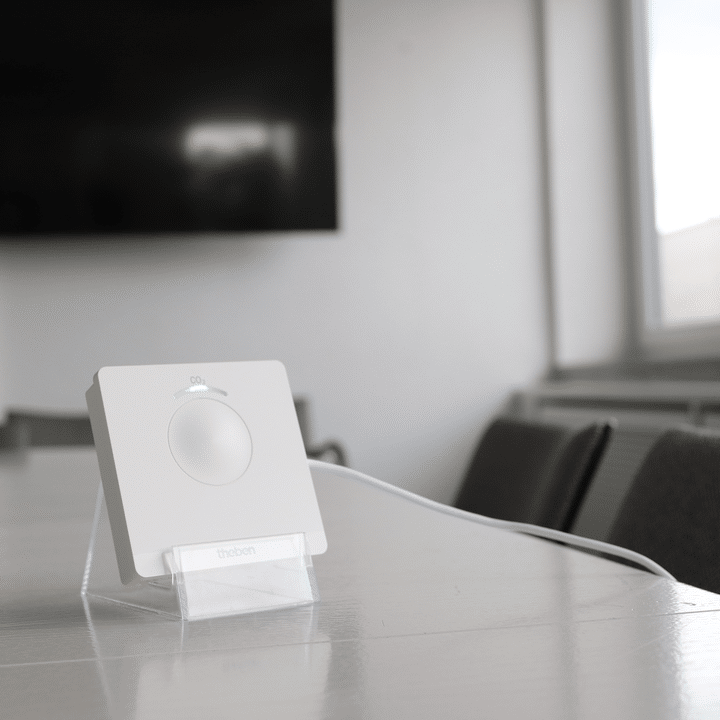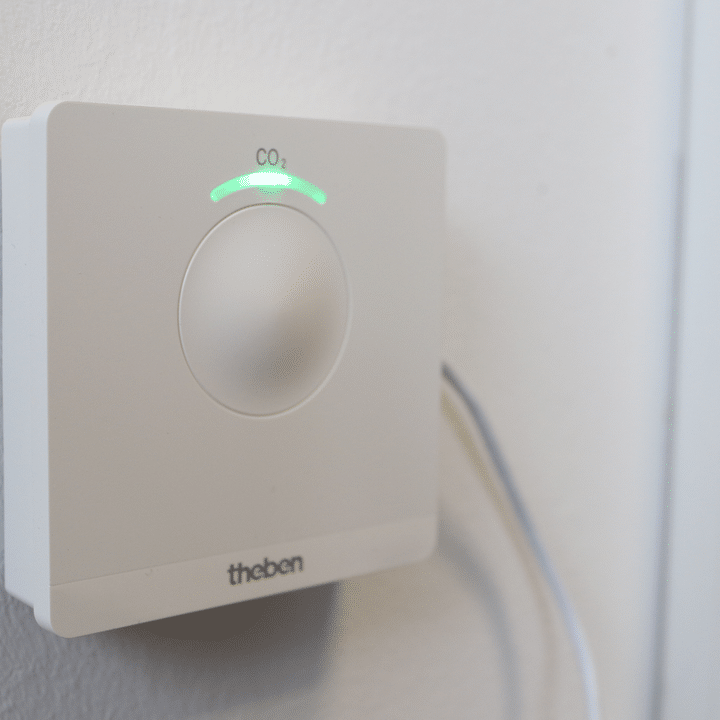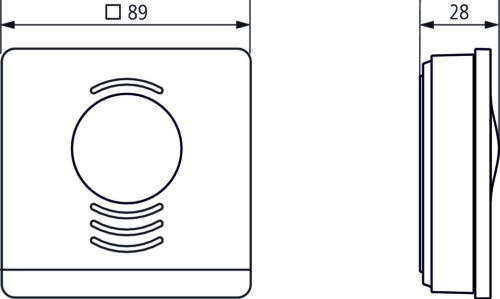Ventilate properly: CO2 sensors from Theben
This site contains comprehensive information on CO2 levels in indoor air and their effects as well as needs-driven and energy-efficient ventilation control using CO2 sensors.
- Mobile CO2 sensor with USB cable for measuring air quality
- Suitable for schools/nurseries, offices, conference or meeting rooms and living spaces
- The device warns optically via the LED traffic light system in case of a potentially dangerous CO2 concentration – so ventilation can be optimized immediately and a healthy room climate can be created
- Green threshold value: Up to 1,000 ppm CO2, hygienically ok, everything is in the green range!
- Threshold value orange: Up to 2,000 ppm CO2, hygienically noticeable, Aeration – good idea!
- Threshold value red: Over 2,000 ppm CO2, hygienically unacceptable, Ventilation is an absolute must!
- Fresh air must be supplied and the used air removed at latest when the red threshold value is reached
- Includes USB cable for easy setup
- Stand and non-slip pad included, alternative wall mounting is also possible
- Development based on the recommendation for CO2 in indoor air of the Federal Environment Agency according to various guidelines, e.g. the Bavarian “Guideline for the Promotion of Investment Costs for Technical Measures for Infection-Protection-Compatible Ventilation in Schools (FILS-R)

Technical data
| Operating voltage | 5 V DC via USB bus voltage |
| Measuring range CO2 | 0 – 5000 ppm |
| Type of connection | USB, cable length 1.5 m |
| Display | 6 LEDs |
| Type of protection | IP 20 |
| Protection class | III |
Classification of breathing air quality according to the Federal Environment Agency
| CO2 content in the room |
Hygienic assessment |
Recommendations |
|---|---|---|
| < 1.000 ppm | hygienically harmless |
|
| 1.000 bis 2.000 ppm | hygienically conspicuous | Check and improve ventilation measures, ventilation behavior |
| > 2.000 ppm |
|
|
Background: Increased CO2 levels and their consequences
We all know about badly ventilated houses, stuffy classrooms and meeting rooms. In addition to humidity and temperature, this is mainly due to exhaled carbon dioxide. An odourless and tasteless gas that is only detected by human beings due to its negative characteristics: feeling unwell, lack of concentration and deterioration in performance. Human beings absorb oxygen from the air when they inhale and release carbon dioxide into the air when they exhale. Inhaled air contains 21% oxygen and 0.035% carbon dioxide. In contrast, exhaled air contains just 16% oxygen and 4% carbon dioxide. While carbon dioxide is only harmful to human beings at concentrations of 2.5% and above, performance levels, concentration and well-being are adversely affected at a concentration of 0.1 % (1,000 ppm).
After just a few minutes, carbon dioxide levels reach 5,000 to 6,000 ppm in enclosed spaces like classrooms, offices or meeting rooms where people often congregate and which are subject to restricted ventilation. Theben CO2 sensors measure CO2 levels reliably. The measured values serve as an indicator for the ventilation control to increase the intake of fresh air.
Excursus: Max von Pettenkofer makes room air quality measurable
Max von Pettenkofer (3. December 1818 to 10. February 1901) was a professor of medical chemistry at the Ludwwig Maximilian University Munich and the first German professor of hygiene from 1865. With his studies on carbon dioxide levels 140 years ago, he laid the foundation for our current regulations relating to air quality (DIN-1946-2). This standard sets an upper CO2 limit of 1,500 ppm. That means there should only be 1,500 CO2 molecules per million air particles.
CO2 level

Caption: Typical CO2 levels (in ppm) and their affect on human beings.
1000 ppm CO2 – the threshold for good indoor air quality
Really good indoor air quality does not exceed a threshold of 1,000 ppm CO2. Therefore, DIN 1946-6 requires an outdoor air flow of 30m3/h per person. A carbon dioxide level of 1,000 ppm CO2 is not achievable by occasional ventilation or opening windows given modern building standards and the thickness of the outer shells of buildings. It is often the case that windows in public buildings such as schools, classrooms or large offices cannot be opened: Good indoor air quality can only be guaranteed in such cases by using a ventilation system controlled by a CO2 sensor.
Application: CO2 sensors in schools, offices, passive and low-energy houses
Due to legal requirements, modern buildings now have very good thermal insulation. In order to keep heating costs as low as possible, windows, outer walls and roofs – the entire building envelope – are so well insulated that an exchange of air is impossible. The result is, in addition to an increased CO2 concentration, also increased moisture, which quickly leads to the formation of mold in the building. Health risks from fungal spores, etc. are thus preprogrammed. In order to sustainably avoid health risks and structural damage, a needs-based supply of fresh air is essential, especially in modern buildings such as passive and low-energy houses.
This is where CO2 sensors from Theben come into play: In addition to the CO2 concentration, CO2 sensors also measure the relative humidity in the building. If defined values are exceeded, CO2 sensors such as the AMUN 716 S KNX send a signal to the building automation, e.g. E.g .: KNX, and the ventilation system increasingly controls fresh air or opens a window automatically. Conventional control is also possible with Theben CO2 sensors such as the AMUN 716 SR: It controls the ventilation system directly.
Ventilation control: CO2 sensors for needs-driven ventilation control
Together with modern building systems technology such as KNX, CO2 sensors make an enormous contribution to saving energy. Ventilation is a matter of guesswork without CO2 sensors. And that’s mostly too late or too much. Too much in this context means heat and heating costs are lost with the exchange of air. This is where Theben CO2 sensors come to the fore: The readings of the CO2 sensor show when, and for how long, ventilation is required. The ventilation system only introduces fresh air as long as it is actually required. In addition to the heating energy saved, speed-controlled ventilation via CO2 sensors also offers large potential savings with fans in ventilation systems. The output of a fan depends on the third power of its speed. A reduction in speed of 20% leads to the halving of electricity consumption.
Volume flow

Caption: CO2 sensors enable great potential savings in energy costs (green surface).
Measurement method: Non-dispersive infrared process
Theben CO2 sensors measure CO2 levels via infrared spectroscopy, also known as non-dispersive infrared process (NDIR). As CO2 reduces the incidence of infrared light on the CO2 sensor, the received signal changes in relation to the CO2 levels in the indoor air.






